engine GMC ENVOY 1998 Owner's Guide
[x] Cancel search | Manufacturer: GMC, Model Year: 1998, Model line: ENVOY, Model: GMC ENVOY 1998Pages: 386, PDF Size: 20.33 MB
Page 157 of 386

To help avoid hearing loss or damage:
0 Adjust the volume control to the lowest setting.
Increase volume slowly until you hear comfortably
and clearly,
NOTICE:
Before you add any sound equipment to your
vehicle
-- like a tape player, CB radio, mobile
telephone or two-way radio
-- be sure you can
add what
you want. If you can, it’s very
important to do it properly. Added sound
equipment may interfere with the operation
of
your vehicle’s engine, Delco Electronics radio or
other systems, and even damage them. Your
vehicle’s systems may interfere with the
operation
of sound equipment that has been
added improperly.
So, before adding sound equipment, check with
your dealer and be sure
to check Federal rules
covering mobile radio and telephone units.
Care of Your Cassette Tape Player
A tape player that is not cleaned regularly can cause
reduced sound quality, ruined cassettes or
a damaged
mechanism. Cassette tapes should be stored
in their
cases away from contaminants, direct sunlight and
extreme heat.
If they aren’t, they may not operate
properly or may cause failure of the tape player.
Your tape player should be cleaned regularly after every
SO hours of use. Your radio may display CLN to indicate
that you have used your tape player for
50 hours without
resetting the tape clean timer. If this message appears on
the display,
your cassette tape player needs to be
cleaned.
It will still play tapes, but you should clean it as
soon
as possible to prevent damage to your tapes and
player.
If you notice a reduction in sound quality, try a
known good cassette to see
if it is the tape or the tape
player at fault,
If this other cassette has no improvement
in sound quality, clean the tape player.
The recommended cleaning method for your cassette
tape player is the use
of a scrubbing action,
non-abrasive cleaning cassette with pads which scrub
the tape head
as the hubs of the cleaner cassette turn.
The recommended cleaning cassette is available through
your dealership
(GM Part No. 12344789).
3-24
ProCarManuals.com
Page 166 of 386

And, of course, actual stopping distances vary greatly
with the surface of the road (whether it‘s pavement or
gravel);
the condition of the road (wet, dry, icy); tire
tread; the condition of your brakes; the weight of the
vehicle and the amount of brake force applied.
Avoid needless heavy braking. Some people drive
in
spurts -- heavy acceleration followed by heavy
braking
-- rather than keeping pace with traffic. This is a
mistake. Your brakes may not have time to cool between
hard stops. Your brakes will wear out rnucit faster
if you
do a lot of heavy braking.
If you keep pace with the
traffic and allow realistic following distances, you
will
eliminate a lot of unnecessary braking. Th, ti t means
better braking and longer brake life.
If your engine ever stops while you’re driving, brake
normally but don’t pump your brakes.
If you do, the
pedal may get harder
to push down. If your engine
stops,
you will still have some power brake assist. But
you will use it when you brake. Once the power assist is
used
up, it may take longer to stop and the brake pedal
will be harder
to push.
Anti-Lock Brakes (ABS)
Your vehicle has anti-lock brakes (ABS). ABS is an
advanced electronic braking system that will help
prevent
;1 braking skid.
When you start your engine and begin to drive away,
your anti-lock brake system
will check itself. You may
hear
a momentary motor or clicking noise while this test
is going on. This is normal.
If there’s a problem with the
anti-lock brake system, this
warning light
will stay on.
See “Anti-Lock Brake
System Warning Light”
in
the Index.
4-7
1
ProCarManuals.com
Page 168 of 386
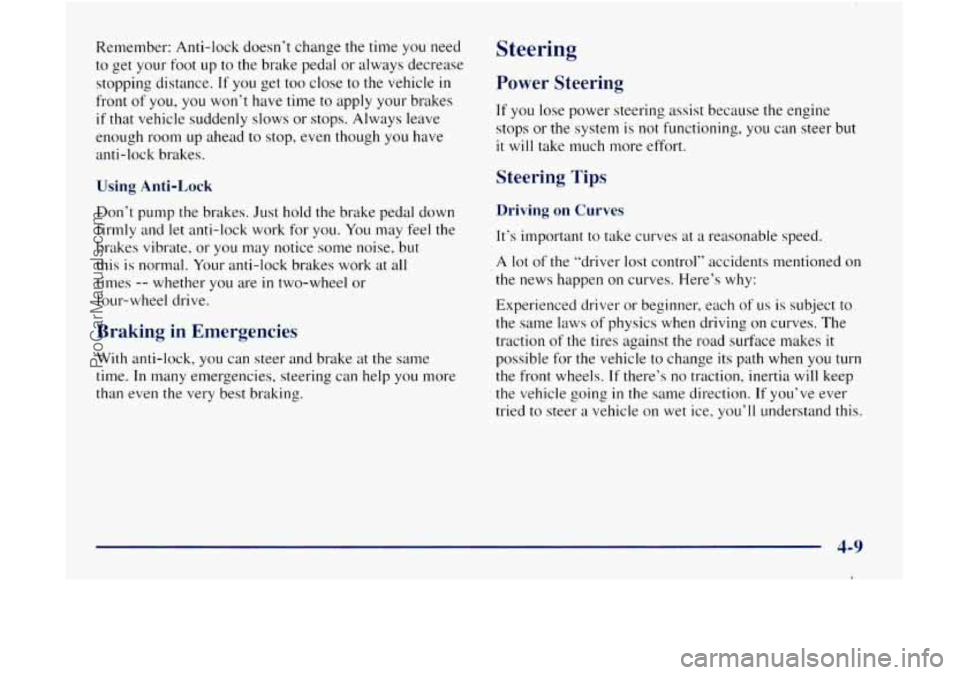
Re,member: Anti-lock doesn’t change the time you need
to get your foot up to the brake pedal or always decrease
stopping distance.
If you get too close to the vehicle in
front of you, you won’t have time to apply your brakes
if that vehicle suddenly slows or stops. Always leave
enough room up ahead
to stop, even though you have
anti-lock brakes.
Steering
Power Steering
If you lose power steering assist because the engine
stops or the system is not functioning, you can steer but
it will take much more effort.
Using Anti-Lock
Don‘t pump the brakes. Just hold the brake pedal down
firmly and let anti-lock work for you. You may feel the
brakes vibrate,
or YOLI may notice some noise, but
this is normal. Your anti-lock brakes work at all
times
-- whether you are in two-wheel or
four-wheel drive.
Braking in Emergencies
With anti-lock, you can steer and brake at the same
time.
In many emergencies, steering can help you more
than even the very best braking.
Steering Tips
Driving on Curves
It’s important to take curves at a reasonable speed.
A lot of the “driver lost control“ accidents mentioned on
the news happen on curves. Here’s
why:
Experienced driver or beginner, each of us is subject to
the same laws of physics when driving on curves. The
traction of the tires against the road surface makes
it
possible for the vehicle to change its path when you turn
the front wheels. If there’s no traction, inertia will keep
the vehicle going
in the same direction. If you’ve ever
tried to steer a vehicle on wet ice, you’ll understand this.
4-9
1
ProCarManuals.com
Page 173 of 386
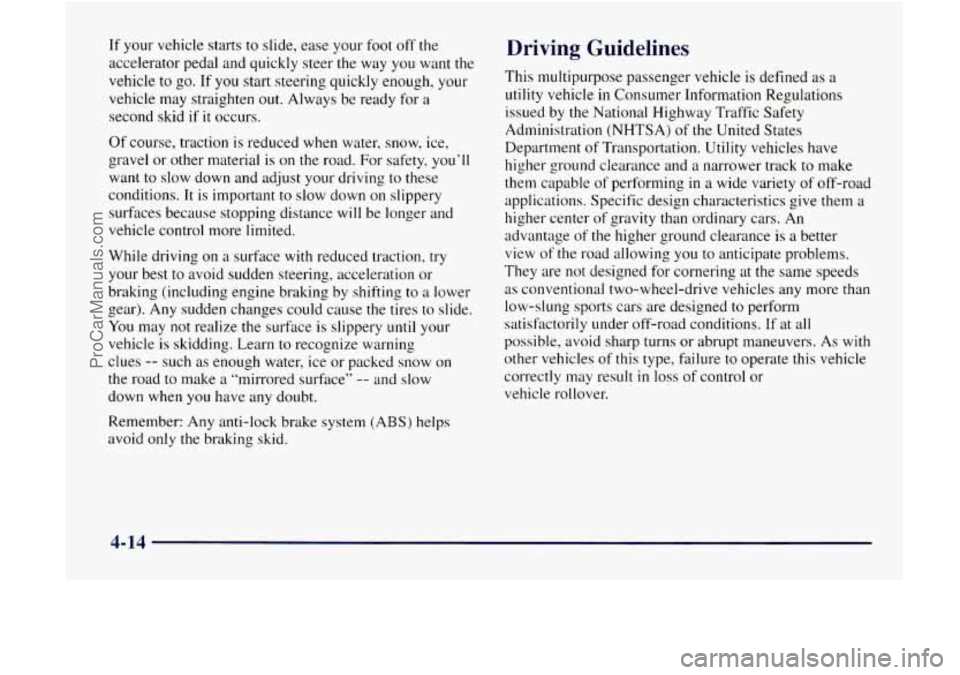
If your vehicle starts to slide, ease your foot off the
accelerator pedal and quickly steer the way you want the
vehicle to go.
If you start steering quickly enough, your
vehicle may straighten out. Always be ready for
a
second skid if it occurs.
Of course, traction is reduced when water, snow, ice,
gravel or other material is
on the road. For safety, you‘ll
want to slow down and adjust your driving to these
conditions.
It is important to slow down on slippery
surfxes because stopping distance will be longer and
vehicle control more limited.
While driving on a surfxe
with reduced traction, try
your best to avoid sudden steering, acceleration
or
braking (including engine braking by shifting to a lower
gear). Any sudden changes could cause the tires to slide.
You may not realize the surfdce is slippery
until your
vehicle is skidding. Learn to recognize warning
clues
-- such as enough water, ice or packed snow on
the road to make a “mirrored surface”
-- and slow
down when
you have any doubt.
Remember: Any anti-lock brake system (ABS) helps
avoid only
the braking skid.
Driving Gu idelines
This multipurpose passenger vehicle is defined as a
utility vehicle in Consumer Information Regulations
issued by the National Highway Traffic Safety
Administration (NHTSA) of
the United States
Department of Transportation. Utility vehicles have
higher ground clearance and a narrower track to make
them capable of performing in a wide variety of off-road
applications. Specific design characteristics give them a
higher center of gravity than ordinary cars. An
advantage of the higher ground clearance is a better
view of the road allowing you
to anticipate problems.
They are not designed for cornering at
the same speeds
as conventional two-wheel-drive vehicles any more than
low-slung sports cars are designed to perform
satisfxtorily under off-road conditions.
If at all
possible, avoid sharp turns
or abrupt maneuvers. As with
other vehicles of this type, failure to operate this vehicle
correctly
may result in loss of control or
vehicle rollover.
4-14
ProCarManuals.com
Page 176 of 386
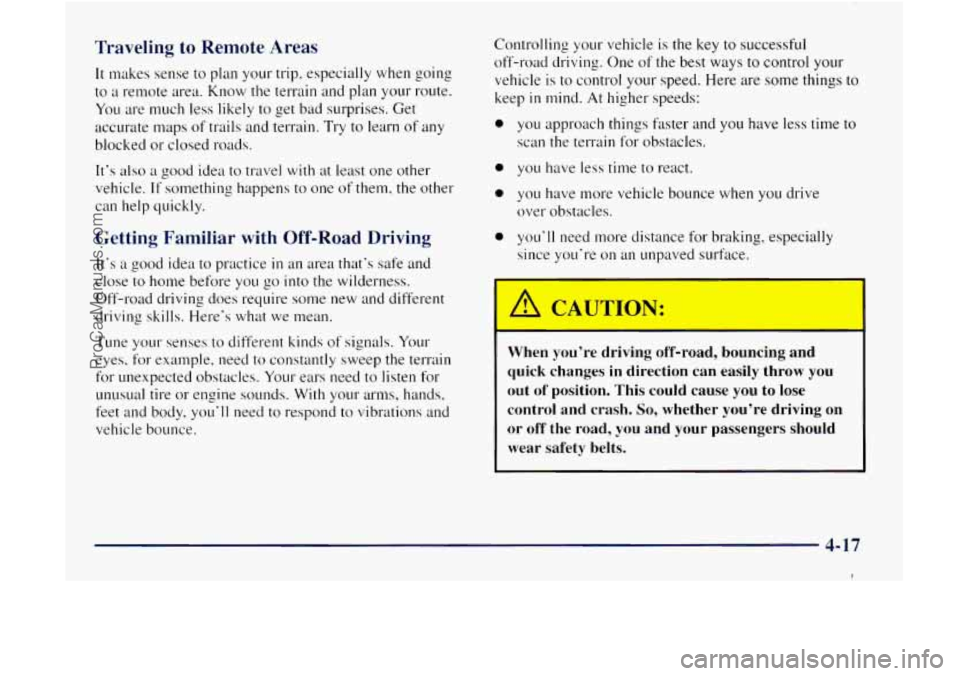
Traveling to Remote Areas
It makes sense to plan your trip, especially when going
to
a remote area. Know the terrain and plan your route.
You are much less likely to get bad surprises. Get
accurate maps of trails and terrain. Try to learn of any
blocked
or closed roads.
It’s also a good idea to travel with at least one other
vehicle.
If something happens to one of them, the other
can help quickly.
Getting Familiar with Off-Road Driving
It’s a good idea to practice in an area that’s safe and
close
to home before you go into the wilderness.
Off-road driving does require some new and different
driving skills. Here’s what we mean.
Tune your senses to different kinds of signals. Your
eyes, for example, need to constantly sweep the terrain
for unexpected obstacles. Your ears need to listen for
unusual tire or engine sounds. With your arms, hands,
feet and body.
you‘ll need to respond to vibrations and
vehicle bounce. Controlling
your vehicle is the
key to successful
off-road driving. One
of the best ways to control your
vehicle is
to control your speed. Here are some things to
keep
in mind. At higher speeds:
0 you approach things faster and you have less time to
scan the terrain for obstacles.
0 you have less time to react.
0 you have more vehicle bounce when you drive
over obstacles.
0 you’ll need more distance for braking, especially
since you’re on an unpaved surface.
A c. u7c-i:
When you’re driving off-road, bouncing and
quick changes in direction can easily throw you
out of position. This could cause you
to lose
control and crash.
So, whether you’re driving on
or off the road, you and your passengers should
wear safety belts.
4-17
I
ProCarManuals.com
Page 180 of 386

What should I do if my vehicle stalls, or is about
to stall, and
I can’t make it up the hill?
A: If this happens, there are some things you should
0
0
0
0
do, and there are some things you must not do.
First, here’s what you
should do:
Push the brake pedal to stop the vehicle and keep
it
from rolling backwards. Also, apply the
parking brake.
If your engine is still running, shift the transmission
to REVERSE
(R), release the parking brake, and
slowly back down the
hill in REVERSE (R).
If your engine has stopped running, you’ll need to restart
it. With the brake pedal depressed and the parking brake
still applied, shift the transmission
to PARK (P) and
restart the engine. Then, shift to REVERSE
(R), release
the parking brake, and slowly back down the
hill as
straight as possible
in REVERSE (R).
As you are backing down the hill, put your left hand
on the steering wheel at
the 12 o’clock position. This
way. you’ll be able to tell
if your wheels are straight
and maneuver
as you back down. It’s best that you
back down the
hill with your wheels straight rather
than
in the left or right direction. Turning the wheel
too far to the left or right will increase the possibility
of
a rollover. Here
are some things you
must r7ot do if you stall, or are
about to stall, when going up
a hill.
0 Never attempt to prevent a stall by shifting into
NEUTRAL
(N) to “rev-up” the engine and regain
forward momentum. This won’t work. Your vehicle
will roll backwards very quickly and you could go
out of control.
Instead, apply the regular brake to stop
the vehicle.
Then apply the parking brake. Shift to REVERSE
(R), release the parking brake, and slowly back
straight down.
0 Never attempt to turn around if you are about to stall
when going up
a hill. If the hill is steep enough to
stall your vehicle, it’s steep enough to cause you to
roll over if you turn around. If you can’t make it up
the
hill, you must back straight down the hill.
Q: Suppose, after stalling, I try to back down the
hill and decide
I just can’t do it. What should
I do?
A: Set the parking brake, put your transmission in
PARK (P) and turn off the engine. Leave the
vehicle and go get some help. Exit on the uphill
side and stay clear of the path the vehicle would
take
if it rolled downhill.
4-21
I
ProCarManuals.com
Page 181 of 386
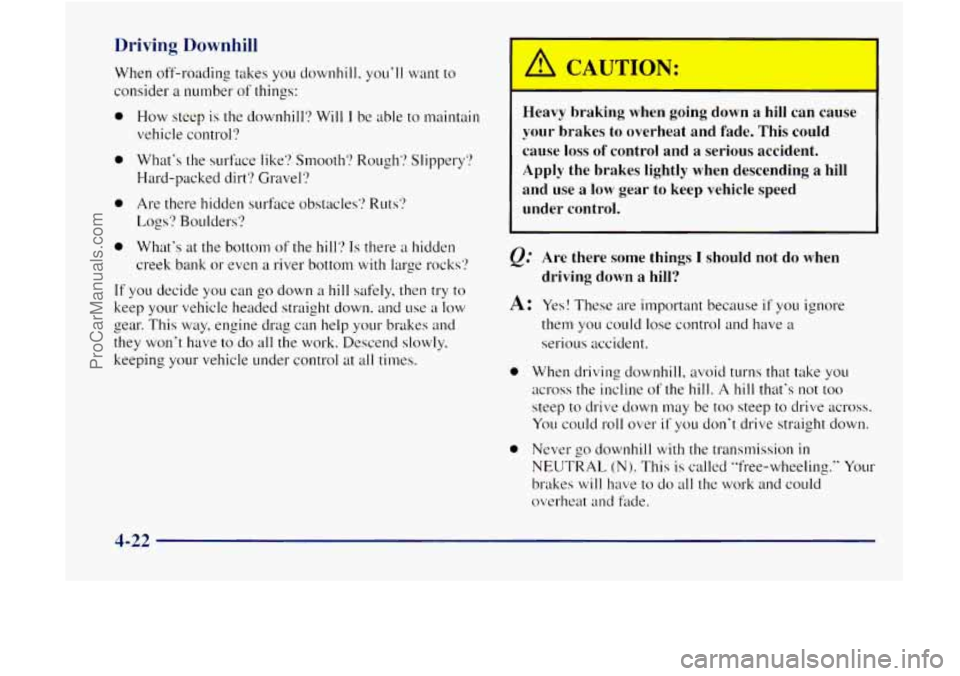
Driving Downhill
When off-roading takes you uownhill, you'll want to
consider
a number of things:
0
0
0
0
How steep is the downhill'? Will I be able to maintain
vehicle control?
What's the surface like'? Smooth'? Rough'? Slippery'?
Hard-packed dirt'? Gravel?
Are there hidden surface
obstacles'! Ruts?
Logs? Boulders'?
What's at the
bottom of the hill'! Is there a hidden
creek bank
or even a river bottom with large rocks?
If you decide you can go down a hill safely. then try to
keep your vehicle headed straight down. and use
a low
they won't have to do
all the work. Descend slowly,
keeping your vehicle under control at
all times.
b "ear. This way, engine drag can help your brakes and
0
0
A CAUTION:
Heavy braking when going down a hill can cause
your brakes
to overheat and fade. This could
cause
loss of control and a serious accident.
Apply the brakes lightly when descending a hill
and use a low gear to keep vehicle speed
under control.
Are there some things
I should not do when
driving down a hill?
A: Yes! These are important because if you ignore
them you could lose control and have
a
serious accident.
When driving downhill, avoid turns that take you
across the incline of the
hill. A hill that's not too
steep to drive down may be too steep to drive ~CI-OSS.
You could roll over
if you don't drive straight down.
Never
go downhill with the transmission in
NEUTRAL (N). This is crdled "free-wheeling." Your
brakes
will have to do all the work and could
overheat and fade.
4-22
ProCarManuals.com
Page 182 of 386
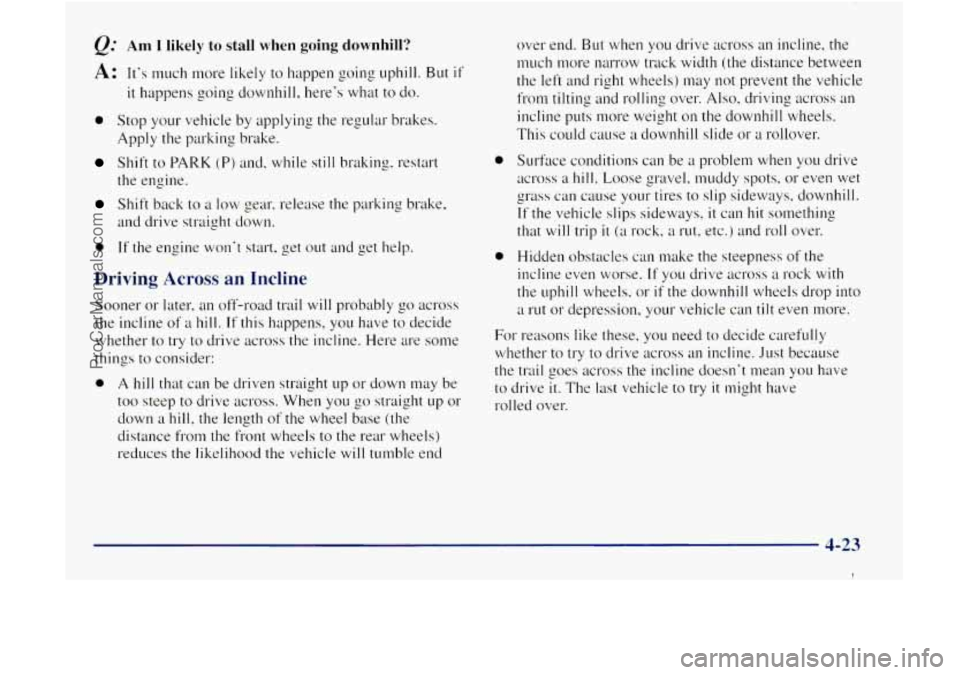
Q.' Am I likely to stall when going downhill?
A: It's much nm-e likely to happen going uphill. But if
it happens going downhill, here's what to do.
0 Stop your vehicle by applying the regular brakes.
Shift to PARK (P) and. while still braking. restart
Apply the parking
brake.
the engine.
Shift back to a low gear, release the parking brake,
and drive straight d6wn.
0 If the engine won't start, get out and get
Driving Across an Incline
Sooner or later, an off-road trail will probab lelp. y go
across
the incline
of a hill. If this happens, you have to decide
whether to
try to dri\:e across the incline. Here are some
things to consider:
0 A hill that can be driven straight up or down may be
too steep to drive across. When you
go straight up or
down a
hill, the length of the wheel base (the
distance from the front wheels
to the rear wheels)
reduces the likelihood the vehicle
will tumble end
0
0
over end. But when you drive across an incline, the
much more narrow track width
(the distance between
the left and right wheels) may not prevent the vehicle
from tilting and rolling over.
Also. driving across an
incline puts more weight on the downhill wheels.
This could cause a downhill slide
or a rollover.
Surface conditions can be
a problem when you drive
across
a hill. Loose gravel, muddy spots, or even wet
If the vehicle slips sideways, it can hit something
that
will trip it (a rock, a rut, etc.) and roll over.
Hidden obstacles can make the steepness
of the
incline even worse.
If you drive across a rock with
the
uphill wheels. or if the downhill wheels drop into
a rut or depression, your vehicle can tilt even n1oI-e.
e orass can cause your tires to slip sideways. downhill.
For reasons like these.
you need to decide carefully
whether to
try to drive across an incline. Just because
the trail goes across the incline doesn't mean you have
to drive it. The last vehicle to try it might have
rolled over.
4-23
I
ProCarManuals.com
Page 185 of 386
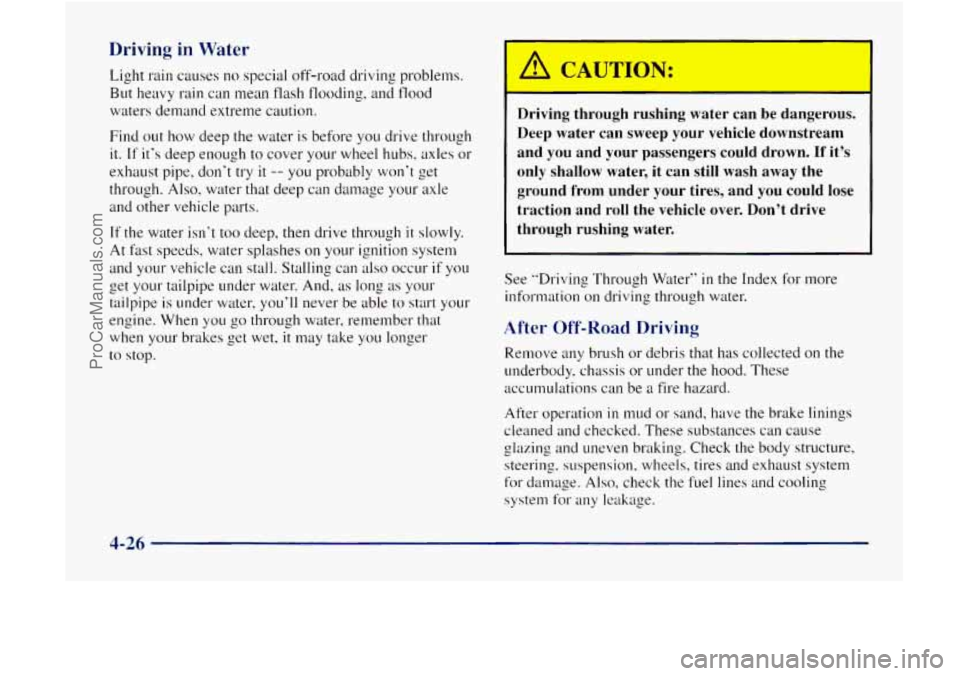
Driving in Water
Light rain causes no special off-road driving problems.
But heavy rain can mean flash flooding, and
flood
waters demand extreme caution.
Find
out how deep the water is before you drive through
it. If' it's deep enough to cover your wheel hubs. axles or
exhaust pipe, don't try it -- you probably won't get
through.
Also, water that deep can damage your axle
and other vehicle parts.
If the water isn't too deep, then drive through it slowly.
At fast speeds, water splashes on your ignition system
and your vehicle can stall. Stalling
can also occur if you
get your tailpipe under water. And, as long as your
tailpipe
is under water? you'll never be able to start your
engine. When you go through water. remember that
when your brakes get wet,
it may take you longer
to stop.
' Driving through rushing water can be dangerous.
Deep water can sweep your vehicle downstream
and
you and your passengers could drown. If it's
only shallow water, it can still wash away the
ground from under your tires, and you could lose
traction and roll the vehicle over. Don't drive through rushing water.
See "Driving Through Wdter" in the Index for more
information
on driving through water.
After Off-Road Driving
Remove any brush or debris that has collected on the
underbody, chassis or under the hood. These
accumulations can
be a fire hazard.
After operation
in mud or sand, have the brake linings
cleaned and checked. These substances can cause
glazing and uneven braking. Check the body structure,
steering, suspension, wheels, tires and exhaust system
for
da1nage. Also, check the fuel lines and cooling
system for any leakage.
4-26
ProCarManuals.com
Page 189 of 386
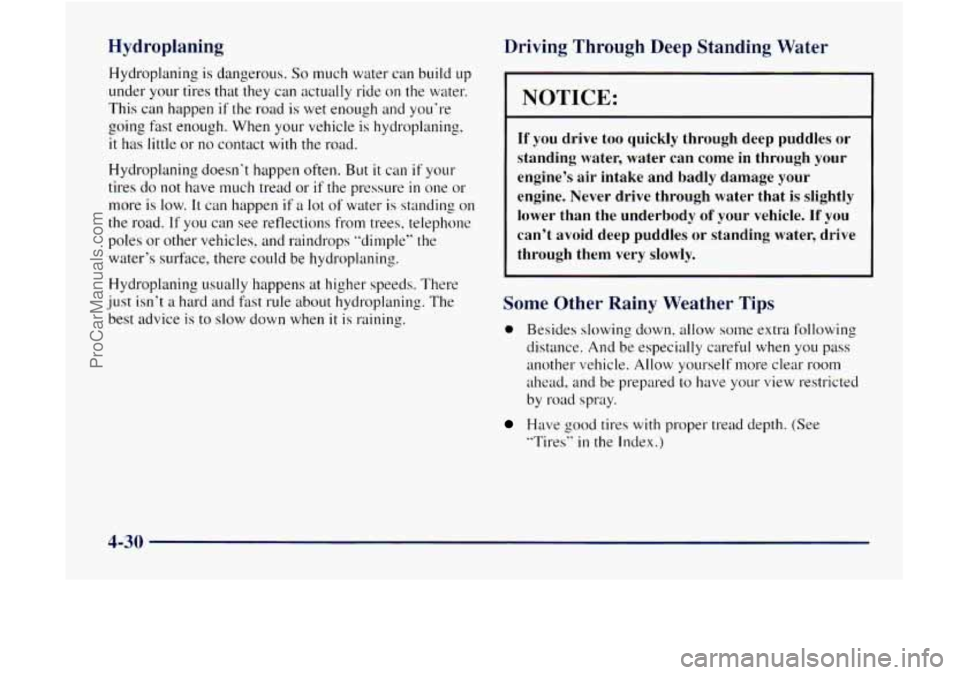
Hydroplaning
Hydroplaning is dangerous. So much water can build up
under your tires that they can actually ride on the water.
This can happen
if the road is wet enough and you’re
going fast enough. When your vehicle is hydroplaning,
it has little or no contact with the road.
Hydroplaning doesn‘t happen often.
But it can if your
tires do not have much tread
or if the pressure in one or
more
is low. It can happen if a lot of water is standing on
the road. If you can see reflections from trees, telephone
poles or other vehicles, and raindrops ”dimple” the
water‘s surface, there could be hydroplaning.
Hydroplaning usually happens at higher speeds. There
just isn’t a hard and fdst rule about hydroplaning. The
best advice
is to slow down when it is raining.
1 )riving Through Deep Standing W ’ Fr
NOTICE:
If you drive too quickly through deep puddles or
standing water, water can come in through your
engine’s air intake and badly damage your
engine. Never drive through water that
is slightly
lower than the underbody
of your vehicle. If’ you
can’t avoid deep puddles or standing water, drive
through them very slowly.
Some Other Rainy Weather Tips
0 Besides slowing down, allow some extra following
distance.
And be especially carefir1 when you pass
another vehicle. Allow yourself more clear room
ahead, and be prepared
to have your view restricted
by road spray.
Have good tires with proper tread depth. (See
“Tires”
in the Index.)
4-30
ProCarManuals.com